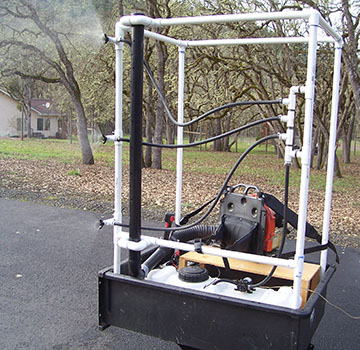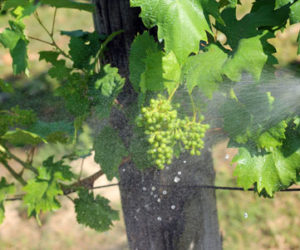
As usual, the “Backyard Vines” column starts with a semi-grave warning. Abandon all hope of watching daytime sporting events in summer if you have a backyard vineyard to tend. Vineyards don’t whine like a dog that needs to go outside, and you may never know there’s a problem in your backyard vineyard until you can see the grey scourge of mildew envelop your vines from your kitchen window. A rank or seldom-loved vineyard is guaranteed to break your heart like a pretty girl from Philadelphia. But unlike a Philly filly, with the proper time, love and respect, the relationship may bear good fruit and leave you more euphoric at the end of the relationship than at the beginning.
So what do we do? My first suggestion may be hard to stomach. If you can’t grow and make wine of a quality you love to drink and share in your backyard, don’t bother. Unless you are a masochist with lots of time to kill and the process informs you in a way that is unique, I’d just save the time, put in some extra hours at work and use the proceeds to buy high quality fruit or just good wine to drink. Instead of pushing and pulling the canopy in the hot summer sun, you can sit in an air conditioned house and sip on Aussie Shiraz.
OK, now that I’ve ticked off or frightened away those who aren’t committed, the initiated and slightly batty can discuss ways to improve the quality of your grapes grown in the city (or the suburbs). There are some specific issues to consider, and I’ve done some research to help you get the best grapes from your vines into the crusher.
Benefits of an urban/suburban vineyard:
• You don’t have to drive to a vineyard to do your work or accept fruit that’s been shipped. Like great cuisine, the best wines are made from fresh, wholesome ingredients. Zinfandel shipped through a hot country on a train will not be as sound as good Norton grown with care and love in your backyard.
• If you’re a committed winegrower, you’re likely a committed winemaker.
• There are likely lots of people in your neighborhood that will help you work in the vineyard, harvest and make wine. Starting a home winemaking club in a city shouldn’t be tough. Take advantage of the dense population of winos in
your vicinity.
• Your neighbors will think you’re cool, and it may even elevate your property value. You’ll be surprised how some things can sell a house: two sinks in the bathroom, a wine cellar that holds 500 bottles, or a well-manicured vineyard to give that urban backyard a sense of Tuscan romance. You don’t have to tell the prospective buyer that the vineyard takes six hours of work each weekend to keep beautiful.
• Offering a barrel tasting is a wonderful bonus at any social gathering. “Oh, I see you have a vineyard in the backyard. Does it actually produce wine?” asks a guest. “Why yes it does,” you reply proudly. “Would you like to taste a bit of the 2010 Sangiovese?”
• Producing fine wine from an urban or suburban environment is a miracle unto itself, like winning the Triple Crown on a draft horse. No one expects it and everyone will admire it. But unlike a trophy or a horse, you can drink wine and it will make you feel better. (And you don’t have to feed a bottle of wine $500 worth of hay every month.)
• As always, the knowledge and intuition gained by growing and making your own wine will guide and inform your love of wine. I know sommeliers who have tasted ten times as many wines as I have, but I can still impress and confound them at a tasting with my understanding of production and nuances that are made obvious by my viticultural and cellar experience.
The perils of urban and suburban winegrape production:
• Your wine might not be good. Wine represents a time and a place in a glass. There’s a reason that my boss’ father and grandfather would wait for the California Zinfandel grapes to arrive at the Paterson, New Jersey train station. Someone had done the hard work of determining that great wine could not be grown in Paterson, and the word spread. You think the Italian backyards wouldn’t have been flowing with vines if a palatable wine could have been made for free? Buying grapes from a bona fide winegrowing region may be your best bet if you talk to the locals and they warn you against planting in a specific locale.
• The neighbors may worry needlessly (especially the teetotalers and chronically uptight). Communicate often with your neighbors about the mildew sprays and your cultural practices. Let them know that grapes require less fungicide/chemical applications than a rose garden. Promise that you will spray in calm weather and there will never be any drift. And as always, ply them with wine. (Unless they don’t drink, in which case I would move elsewhere.)
• The mildew and/or rot will keep you up at night. Every home winegrower I know has a mildew story, and it usually goes like this: “I had no idea that mildew was growing in my vineyard until it was too late. I guess I really have to keep up with weekly sprays.” I would suggest (with no evidence, but plenty of bluster) that mildew and rot have wrecked more potential homegrown wine than good wine has been made at home in total. Whether it’s a section of the vineyard that got hit hard and had to be left out of the production, or a third of your crop of fruit had to be dropped to protect the remaining usable fruit, learning proper fungicide application timing may be the best way to guarantee you will at least have some usable fruit come the fall. Mildew thrives in warm, humid weather. Temperatures around 75–85 °F (24–29 °C) are prime conditions for mildew growth, and require very careful observation and application. Wettable or powder sulfur applied each week is a good start, but you may need to find an alternative for the vines when the clusters start to enlarge and the berries start touching. Sulfur trapped within the cluster at bunch closure will put some serious stink in your wine. The benefit of sulfur is that it is low impact, cheap, and because it is elemental, the vines have no capacity to become resistant to it. Of course the best fungicides usually require an agricultural permit, so you need to have a serious discussion with your local grape growing club, an academic at a local college or university, or a nurseryman about legal options for non-sulfur late season mildew control. Another pro tip: mixing tiny amounts of fungicide in a backpack sprayer often leads to toxic concentrations. If the label says 1 lb. per 20 gallons, 2 lb. will NOT be more efficient. Buy a very accurate scale and do your math twice to make sure you don’t miss a decimal point and poison your vines.
• Municipal water is not necessarily great for agriculture. City and suburban water may contain chlorine and fluorine in small molecular concentrations. It will likely contain salts as well. There are a few ways to mitigate the negative influence. Putting city water in buckets and allowing it to sit for a few days in the sun will remove a decent amount of chlorine. Using rain-collection is your best bet, though, as rainwater is always better for plants than domestic or city water. Unless you are totally dependent on city water for irrigation (desert environment with less than 10 inches/25 cm of rain a year, for example), you likely won’t see serious problems from using some city water. A good rule of thumb: if your landscaping has no problems using your local water, the vines will probably be fine. If the vines and your landscaping are yellow, scorched and you’ve eliminated the possibility that it is a virus, you may not be able to grow grapes with city water.
• Who knows what people have dumped in their backyards!? There may be a part of your vineyard that never grows — and it’s because someone dumped motor oil there twenty years ago. It will confound you, you will never know the truth, but go ahead and blame all difficult parts of a home vineyard on environmental poisoning. It’ll make you feel better that it was someone else’s stupidity, and it probably was.
• Critters live in the city too. With the great likelihood of Norway rats, possums, raccoons, squirrels and starlings in your neighborhood, you can plan on having some urban/suburban thieves come for your fruit. While some critters may have grown fat and lazy on trash and handouts, many animals find it very difficult to resist the lure of fresh, ripe grapes on the vine. Netting is relatively cheap and effective, but I have still not found a way to keep squirrels from finding a way around and into the nets, so you may have to live with a little vertebrate-pest loss each vintage. Dogs, cats and B-B guns may help.
• Your space may be limited and high vine density may be a really bad idea. If you don’t have much space, you may be tempted to plant a high density vineyard in the hopes of getting more vines in the ground, thereby getting more wine from your backyard. You may have read somewhere that great French vineyards are planted meter-by-meter in spacing. Believe me when I say you can ignore every French rule of viticulture if you want to grow good wine in the North America. This is not because their science is poor, or their research faulty. Quite the opposite. French viticulture is designed to make great French wines. Wines of a place. And that place is not Virginia, or Oregon or California. What the French truly teach us is that we need to develop our own, unique wine culture here. Experiment, slow down, don’t be in such a hurry to find greatness. People are growing diverse grapes in new regions and getting better at it every year. But back to vine spacing. More backyard vineyards have a problem with extra vigor as opposed to a lack of vigor. 3-foot x 3-foot (~1-m x 1-m) spacing in a high vigor site is a guarantee of poor quality, shaded, vegetal fruit. You will also have a hard time walking between the rows after June without a machete. Four to 6 feet (1.2 to 1.8 m) between plants and at least the same between rows would almost be the minimum allowable density for normal vigor backyard vineyards. Remember that row-to-row spacing should be a 1:1 ratio with anticipated canopy height. So if a 24-inch (31 cm) fruiting wire produced a 5-foot (1.5-m) cane in a year, that means you need 7 feet (2.1 m) between rows, minimum for proper sun exposure. Allowing a vine to stretch out and push enough buds to channel its vigor will keep shoot growth under 5 feet (1.5 m) in a vintage, which will produce wines of better ripeness and balance.
• There’s shade . . . everywhere! Living in the city or the near-city almost guarantees the presence of shade over much of your backyard in any given part of the day. The more city-guerrilla the vineyard, the more shade you can expect. There’s no simple way to say it — shade makes for generally vegetal fruit. Pay attention to your backyard for a few years before planting and only plant in the sunniest areas. Do experiments in leaf pulling and see how extreme you can go without burning the fruit. It is always better to make 5 gallons (19 L) of decent wine than a whole barrel of veggie wine no one wants to drink.




